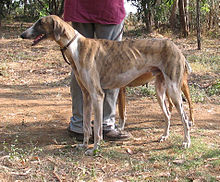Mudhol Hound
| Mudhol Hound | |||||||||
|---|---|---|---|---|---|---|---|---|---|
 | |||||||||
| Other names | Maratha Hound Pashmi Hound Kathewar Dog | ||||||||
| Origin | Mudhol, Karnataka State, India | ||||||||
| |||||||||
| Dog (domestic dog) | |||||||||
The Mudhol Hound, also known variously as the Maratha Hound, the Pashmi Hound and the Kathewar Dog, is a breed of sighthound from India.[1][2][3][4]
The Kennel Club of India (KCI) and Indian National Kennel Club (INKC) recognize the breed under different breed names. The KCI registers it as a Caravan Hound while the INKC uses the name Mudhol Hound.[citation needed]
In 2005 the Mudhol Hound was one of four Indian dog breeds featured on a set of postage stamps released by the Indian Ministry of Communications and Information Technology to celebrate the country's canine heritage.[5]

About 750 families in and around Mudhol town of Karnataka are raising this breed for marketing the puppies.[6]
History
The Caravan was introduced to the Deccan Plateau of western India from Central Asia and Arabia, and can thus be considered a direct descendant of the Saluki or Tāzī. This region covers parts of the states of Karnataka, Maharashtra, and, to a lesser degree, Telangana. The breed is popular in and around Mudhol Taluk of Karnataka and thus the breed got the name Mudhol hound.[7]
Shrimant Rajesaheb Malojirao Ghorpade of Mudhol (1884-1937) of the Mudhol State is credited with reviving the Mudhol hound. He noticed local tribal people called Bedar (Fearless); also called Berad (not - crying) using these hounds for hunting.[6] Using selective breeding, he was able to restore the royal Mudhol hound. On a visit to England in the early 1900s, the Maharaja of Mudhol State presented King George V a pair of hounds, which popularized the Mudhol hound breed.[8][9]
The Indian Army has expressed its desire to use the Mudhol sight hound for surveillance and border protection duties. It has obtained six Mudhol dogs for testing at the Army's Remount Veterinary Corps at Meerut. The dogs were bred after selection, at the Canine Research and Information Centre in Thimmapur near Mudhol in Bagalkot district of Karnataka. The CRIC is a unit of the Karnataka Veterinary, Animal and Fisheries Sciences University, Bidar.[10]
References
- ^ Fogle, Bruce (2009). The encyclopedia of the dog. New York: DK Publishing. p. 103. ISBN 978-0-7566-6004-8.
- ^ Hancock, David (2012). Sighthounds: their form, their function and their future. Ramsbury, Marlborough: The Crowood Press Ltd. pp. 109–112. ISBN 978-1-84797-392-4.
- ^ Morris, Desmond (2001). Dogs: the ultimate guide to over 1,000 dog breeds. North Pomfret, VT: Trafalgar Square Publishing. pp. 47–48. ISBN 1-57076-219-8.
- ^ Soman, W.V. (1962). The Indian Dog. Mumbai: Popular Prakashan. p. 89.
- ^ Upadhye, Aishwarya (1 February 2019). "The comeback of Indian native dog breeds". The Hindu. Chennai. Retrieved 28 July 2020.
- ^ a b Menasinakai, Sangamesh (2 August 2015). "Mudhol's top dogs". The Times of India, Newspaper. Retrieved 2 August 2015.
- ^ "Mudhol Hound has its day". The Hindu. 5 March 2007. Retrieved 29 July 2014.
- ^ Jadeja, Arjunsinh (27 January 2015). "Tracking the hounds of Mudhol". No. Bangalore. Deccan Herald. Retrieved 2 February 2015.
- ^ Jadeja, Arjunsinh (23 July 2013). "Mudhol's royal chapter". No. Bangalore. Deccan Herald. Retrieved 2 February 2015.
- ^ "Mudhol hounds now get a fighting chance". The Hindu. 13 November 2015. Retrieved 6 May 2016.
